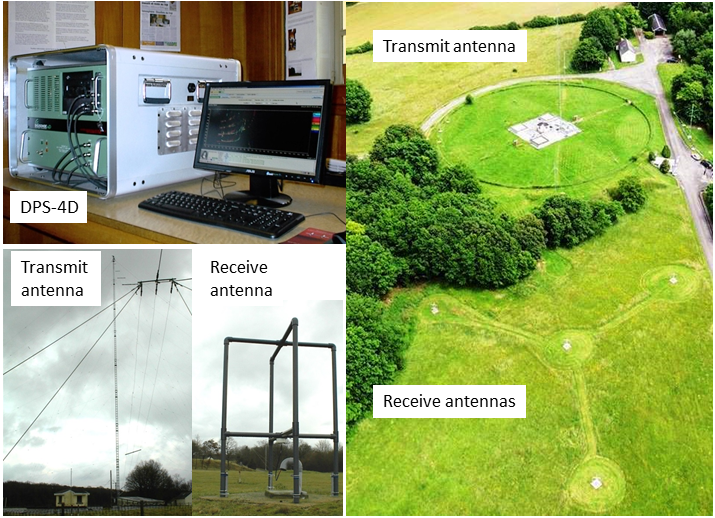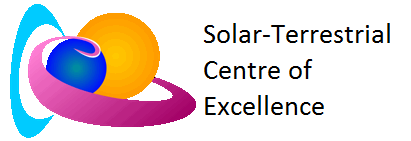Ionospheric Sounder
The principal instrument utilised for ionospheric observations at the RMI Geophysical Centre in Dourbes is the digital ionospheric sounder (URSI code: DB049)—a Lowell Digisonde-4D, also known as the Digital Portable Sounder, DPS-4D (Reinisch et al., 2009).
The DPS-4D is state-of-the-art equipment using high-frequency (HF) radar principles of remote sensing to evaluate with high-accuracy and precision the conditions of the ionospheric plasma above the ionosonde station. It boasts multiple functionalities supported by a fully automated operational and database management system. It is capable of simultaneously measuring the following observables reflected (in vertical incidence) or refracted (in oblique incidence) signals from the ionosphere: frequency, range, amplitude, phase, Doppler shift and spread, angle of arrival, and wave polarisation.
Signal transmission is performed with two (NE–SW and NW–SE) crossed “delta” antennas of 40 m in height and reception is done with an array of four crossed magnetic dipole receive antennas in a triangular arrangement. The Digisonde is equipped with the latest versions of the computer software for automatic ionogram interpretation, ARTIST-5 (Galkin et al., 2008), and Digisonde Drift Analysis, DDA (Kozlov and Paznukhov, 2008).

The DPS-4D is a powerful tool in ionospheric nowcast and forecast because of its improved reliability, accuracy and precision, its ability to automatically scale and analyse the sounding data, and also to promptly distribute the results through internet connections. It has also clear advantages of speed, time resolution, and significantly reduced cost of maintenance.
Key practical applications of the digital ionosonde:
- The modern digital ionosonde is capable of promptly evaluating with high-accuracy and precision the conditions of the ionospheric plasma above the ionosonde location. As such, the ionosondes are key instruments and major contributors to the modern ionospheric and space science research.
- Digital ionosondes provide real-time data to prepare high-accuracy ionospheric specifications and forecasts for communications, surveillance and navigation systems
- Networked digisondes are used to produce (near) real-time maps of key ionospheric characteristics over a certain region (e.g. Europe) or on a global scale.
- Digisonde data are used as key reference in various data assimilation techniques and for developing global empirical ionospheric models (e.g. IRI, the standard International Reference Ionosphere model).
- Digisondes are used for ionospheric and space weather forecasts and warnings to the military to enable their services. This involves the specification and forecasting of radio propagation conditions as they impact systems which either require the ionosphere for their operation (HF propagation) or which have to work through the ionosphere (satellite communication, Global Navigation Satellite Systems), often against the background of a disturbed ionosphere (space surveillance radars).
Our digital ionospheric sounder at the RMI Geophysical Centre in Doubes (50.1°N,4.6°E) is used, together with the co-located GPStation-6 GISTM, in the operation of the local ionospheric specification and visualisation system LIEDR (Stankov et al., 2011).
References:
Galkin, I.A., Khmyrov, G.M., Kozlov, A.V., Reinisch, B.W., Huang, X., and Paznukhov, V.V. (2008): The ARTIST 5. in: P. Song, J.C. Foster, M. Mendillo, and D. Bilitza, (Eds.), Radio Sounding and Plasma Physics, AIP Conference Proc. 974, 150–159, (doi:10.1063/1.2885024).
Kozlov, A.V. and Paznukhov, V.V. (2008): Digisonde Drift Analysis Software. in: P. Song, J.C. Foster, M. Mendillo, and D. Bilitza, (Eds.), Radio Sounding and Plasma Physics, AIP Conference Proc. 974, 167–174, (doi:10.1063/1.2885026).
Reinisch, B.W., Galkin, I.A., and Khmyrov, G.M. (2009): New Digisonde for research and monitoring applications. Radio Science, 44(1), RS0A24, (doi:10.1029/2008RS004115).
Stankov, S.M., Stegen, K., Muhtarov, P., Warnant R. (2011): Local ionospheric electron density profile reconstruction in real time from simultaneous ground-based GNSS and ionosonde measurements. Advances in Space Research, 47(7), 1172–1180, (doi:10.1016/j.asr.2010.11.039). (download)

